Water, Energy and Food Algorithm with Optimal Allocation and Sizing of Renewable Distributed Generation for Power Loss Minimization in Distribution Systems (WEF)
Abstract
:1. Introduction
2. Basic Water, Energy, and Food (WEF) Optimization Algorithm Review
2.1. Water, Energy, and Food (WEF)
2.2. Dragonfly Algorithm (DFA)
- X denotes the current position of the dragonflies,While is the jth neighboring individuals.N is the number of neighboring individuals
- The alignment fitness is computed as follows:Considering the movement velocity as Vi, in the matching process as searching is taking place.Jth is the velocity of neighboring.
- The cohesion is computed to attract the swarm towards the middle point of the grouping swarm.X is the current position of individualN is the number of NeighborhoodDenotes the position at neighboring individual
- The food attraction by the swarm is mathematically computed to, attract the swarm.X is the current position of the individualThe position of the food attraction source
- During Food attraction, the enemy is always present and must put into considerationis the enemy position, while in the initial position.
2.3. Active Power Loss Minimization
2.4. Constraints
2.5. Overall System Efficiency
3. Distributed Energy Resources Modelling (DER)
3.1. Problem Formulation for Proposed Algorithm
- It has an infinite number of solutions and this has made it simple to fix our DG in many points within the Distribution system.
- A probabilistic solution generates several solutions for the whole WEF Renewable hybrid DG, thereby providing an optimal solution to minimize energy loss.
- β: Denotes the constant values of the energy in wind
- γ: Denotes the constant values of solar energy
- α: Denotes the fuel cell energy constants
- ρ: Probabilitymeasuresontheenergyspaceforthe3DG^’ s such that Ei(:)i = 0,1
- μ: rate at which an element is used in the Distribution system
- L: The state of wind energy DG in a Distribution System
- i: The state of solar energy DG in a Distribution network system
- j: The state of fuel energy DG in a Distribution network system.
3.2. Objective Functions Formulations
3.3. Wind Speed Modeling and Power Output
3.4. Solar PV Modeling and Power Output Calculation
3.5. Minimization of Emission
3.6. Minimization of Cost
3.7. Application of Dragonfly to Determine the Optimal Size of the Distributed Energy Resources
| Algorithm 1. Application of dragonfly to determine the optimal size of the distributed energy resources. |
| Initialize the dragonflies’ population such as Xi (1, 2, 3…….n) (i = 1, 2 …n) using Equations (1) and (2) While the requirement for end conditions not satisfied Compute the objective conditions for all dragonflies Update the food source and enemy present Update the values of (k, v, c, f, and e) defined earlier Compute the values of Ki, Vi, Ci, fi, and Ei using Equations (6) and (7) Update the nearest radius If a dragonfly have at least a single nearest dragonfly Update the state vector velocity using Equation (6) Update the vector position using Equation (7) else Update position vector using Equation (8) end if The new positions are within the defined boundaries end while |
3.8. Flowchart for Configuration
4. Numerical Simulations and Validation Approximations
4.1. 33-Bus Test System
4.2. Results and Discussion
4.3. Power Losses
5. Conclusions
Author Contributions
Funding
Institutional Review Board Statement
Informed Consent Statement
Data Availability Statement
Conflicts of Interest
References
- Sulaiman, M.H.; Mustafa, M.W.; Azmi, A.; Aliman, O.; Abdul Rahim, S.R. Optimal allocation and sizing of distributed generation in distribution system via firefly algorithm. In Proceedings of the 2012 IEEE International Power Engineering and Optimization Conference (PEOCO2012), Melaka, Malaysia, 6–7 June 2012; pp. 84–89. [Google Scholar]
- Chatterjee, S. An analytic method for allocation of Distributed Generation in radial distribution system. In Proceedings of the IEEE Indicon, New Delhi, India, 17–20 December 2015; pp. 4–8. [Google Scholar]
- Huda, A.S.N.; Živanović, R. Large-scale integration of distributed generation into distribution networks: Study objectives, review of models and computational tools. Renew. Sustain. Energy Rev. 2017, 76, 974–988. [Google Scholar] [CrossRef]
- Ehsan, A.; Yang, Q. Optimal integration and planning of renewable distributed generation in the power distribution networks: A review of analytical techniques. Appl. Energy 2018, 210, 44–59. [Google Scholar] [CrossRef]
- Li, Y.; Feng, B.; Li, G.; Qi, J.; Zhao, D.; Mu, Y. Optimal distributed generation planning in active distribution networks considering integration of energy storage. Appl. Energy 2018, 210, 1073–1081. [Google Scholar] [CrossRef] [Green Version]
- Sudabattula, S.; Kowsalya, M. Optimal Allocation of Wind Based Distributed Generators in Distribution System Using Cuckoo Search Algorithm. Procedia Comput. Sci. 2016, 92, 298–304. [Google Scholar] [CrossRef] [Green Version]
- Rao, R.S.; Ravindra, K.; Satish, K.; Narasimham, S.V.L. Power loss minimization in distribution system using network reconfiguration in the presence of distributed generation. IEEE Trans. Power Syst. 2013, 28, 317–325. [Google Scholar] [CrossRef]
- Georgilakis, P.S.; Hatziargyriou, N.D. In Power Distribution Networks: Models, Methods, and Future Research. IEEE Trans. Power Syst. 2013, 28, 3420–3428. [Google Scholar] [CrossRef]
- Acharya, N.; Mahat, P.; Mithulananthan, N. An analytical approach for DG allocation in primary distribution network. Int. J. Electr. Power Energy Syst. 2006, 28, 669–678. [Google Scholar] [CrossRef]
- Wang, C.; Nehrir, M.H. Analytical approaches for optimal placement of distributed generation sources in power systems. IEEE Trans. Power Syst. 2004, 19, 2068–2076. [Google Scholar] [CrossRef]
- Gözel, T.; Hocaoglu, M.H. An analytical method for the sizing and siting of distributed generators in radial systems. Electr. Power Syst. Res. 2009, 79, 912–918. [Google Scholar] [CrossRef]
- Hung, D.Q.; Mithulananthan, N.; Bansal, R.C. Analytical expressions for DG allocation in primary distribution networks. IEEE Trans. Energy Convers. 2010, 25, 814–820. [Google Scholar] [CrossRef]
- Moradi, M.H.; Abedini, M. A combination of genetic algorithm and particle swarm optimization for optimal distributed generation location and sizing in distribution systems with fuzzy optimal theory. Int. J. Green Energy 2012, 9, 641–660. [Google Scholar] [CrossRef]
- El-Zonkoly, A.M. Optimal placement of multi-distributed generation units including different load models using particle swarm optimization. Swarm Evol. Comput. 2011, 1, 50–59. [Google Scholar] [CrossRef]
- Jain, N.; Singh, S.N.; Srivastava, S.C. A generalized approach for DG planning and viability analysis under market scenario. IEEE Trans. Ind. Electron. 2013, 60, 5075–5085. [Google Scholar] [CrossRef]
- Abu-Mouti, F.S.; El-Hawary, M.E. Optimal distributed generation allocation and sizing in distribution systems via artificial bee colony algorithm. IEEE Trans. Power Deliv. 2011, 26, 2090–2101. [Google Scholar] [CrossRef]
- Tolba, M.A.; Tulsky, V.N.; Diab, A.A.Z. Optimal Allocation and Sizing of Multiple Distributed Generators in Distribution Networks Using a Novel Hybrid Particle Swarm Optimization Algorithm. In Proceedings of the 2017 IEEE Conference of Russian Young Researchers in Electrical and Electronic Engineering (EIConRus), St. Petersburg/Moscow, Russia, 1–3 February 2017; pp. 1606–1612. [Google Scholar]
- Parizad, A.; Khazali, A.H.; Kalantar, M. Sitting and sizing of distributed generation through Harmony Search Algorithm for improve voltage profile and reducuction of THD and losses. In Proceedings of the Canadian Conference on Electrical and Computer Engineering (CCECE) 2010, Calgary, AB, Canada, 16 September 2010. [Google Scholar]
- Khalesi, N.; Rezaei, N.; Haghifam, M.R. DG allocation with application of dynamic programming for loss reduction and reliability improvement. Int. J. Electr. Power Energy Syst. 2011, 33, 288–295. [Google Scholar] [CrossRef]
- Kumar, S.; Kumar, N.P. Electrical Power and Energy Systems A novel approach to identify optimal access point and capacity of multiple DGs in a small, medium and large scale radial distribution systems. Int. J. Electr. Power Energy Syst. 2013, 45, 142–151. [Google Scholar]
- Zhang, H.; Vittal, V.; Heydt, G.T.; Quintero, J. A mixed-integer linear programming approach for multi-stage security-constrained transmission expansion planning. IEEE Trans. Power Syst. 2012, 27, 1125–1133. [Google Scholar] [CrossRef]
- Hung, D.Q.; Mithulananthan, N. Multiple distributed generator placement in primary distribution networks for loss reduction. IEEE Trans. Ind. Electron. 2013, 60, 1700–1708. [Google Scholar] [CrossRef]
- Yuvaraj, T.; Devabalaji, K.R.; Ravi, K. Optimal Placement and Sizing of DSTATCOM Using Harmony Search Algorithm; Elsevier B.V.: Amsterdam, The Netherlands, 2015; Volume 79, ISBN 1876-6102. [Google Scholar]
- Murthy, V.V.S.N.; Kumar, A. Comparison of optimal DG allocation methods in radial distribution systems based on sensitivity approaches. Int. J. Electr. Power Energy Syst. 2013, 53, 450–467. [Google Scholar] [CrossRef]
- Tan, W.S.; Hassan, M.Y.; Rahman, H.A.; Abdullah, P. Multi-distributed generation planning using hybrid particle swarm optimisation-gravitational search algorithm including voltage rise issue. IET Gener. Transm. Distrib. 2013, 7, 929–942. [Google Scholar] [CrossRef]
- Mahmoud, G.A.E.-A.; Oda, E.S.S. Investigation of Connecting Wind Turbine to Radial Distribution System on Voltage Stability Using SI Index and λ-v Curves. Smart Grid Renew. Energy 2016, 7, 16–45. [Google Scholar] [CrossRef] [Green Version]
- Hanumantha Rao, B.; Sivanagaraju, S. Optimum allocation and sizing of distributed generations based on clonal selection algorithm for loss reduction and technical benefit of energy savings. In Proceedings of the 2012 International Conference on Advances in Power Conversion and Energy Technologies (APCET), Mylavaram, Andhra Pradesh, 2–4 August 2012; pp. 1–5. [Google Scholar]
- Abdelsalam, A.A.; Zidan, A.A.; El-Saadany, E.F. Optimal DG Allocation in Radial Distribution Systems with High Penetration of Non-linear Loads. Electr. Power Compon. Syst. 2015, 43, 1487–1497. [Google Scholar] [CrossRef]
- Bin Muhtazaruddin, M.N.; Fujita, G. Distribution network power loss by using Artificial Bee Colony. In Proceedings of the 2013 48th International Universities’ Power Engineering Conference (UPEC), Dublin, Ireland, 2–5 September 2013. [Google Scholar]
- Hegazy, Y.G.; Othman, M.M.; El-Khattam, W.; Abdelaziz, A.Y. Optimal sizing and siting of distributed generators using Big Bang Big Crunch method. In Proceedings of the 2014 49th International Universities Power Engineering Conference (UPEC), Cluj-Napoca, Romania, 2–5 September 2014; pp. 1–6. [Google Scholar]
- El-Fergany, A. Study impact of various load models on DG placement and sizing using backtracking search algorithm. Appl. Soft Comput. J. 2015, 30, 803–811. [Google Scholar] [CrossRef]
- Sani, S.; Shuaibu, A.; Tumushabe, A.; Mbatudde, M. Modeling the Water-Energy-Food Nexus in ObR-E’s: The Eight (8) Coordinates. Appl. Appl. Math. Int. J. 2019, 14, 27. [Google Scholar]
- Jin, L.; Chang, Y.; Ju, X.; Xu, F. A Study on the Sustainable Development of Water, Energy, and Food in China. Int. J. Environ. Res. Public Health Artic. 2019, 16, 3688. [Google Scholar] [CrossRef] [Green Version]
- Diamond, J. Collapse: How Societies Choose to Fail or Succeed. ISBN 0670033375. Wikipedia. United States. 2005. Available online: https://en.wikipedia.org/wiki/Collapse:_How_Societies_Choose_to_Fail_or_Succeed (accessed on 20 February 2022).
- Al-saidi, M.; Elagib, N.A. Science of the Total Environment Towards understanding the integrative approach of the water, energy and food nexus. Sci. Total Environ. 2017, 574, 1131–1139. [Google Scholar] [CrossRef]
- Mirjalili, S. Dragonfly algorithm: A new meta-heuristic optimization technique for solving single-objective, discrete, and multi-objective problems. Neural Comput. Appl. 2016, 27, 1053–1073. [Google Scholar] [CrossRef]
- Oda, E.S.; Abdelsalam, A.A.; Abdel-Wahab, M.N.; El-Saadawi, M.M. Distributed generations planning using flower pollination algorithm for enhancing distribution system voltage stability. Ain Shams Eng. J. 2017, 8, 593–603. [Google Scholar] [CrossRef] [Green Version]
- Ekpa, T.K.; Sani, S.; Hassan, A.S.; Kalyankolo, Z. On Improving Power Supply Flexibility. J. Niger. Assoc. Math. Phys. 2018, 48, 347–352. [Google Scholar]
- Sanjay, R.; Jayabarathi, T.; Raghunathan, T.; Ramesh, V.; Mithulananthan, N. Optimal allocation of distributed generation using hybrid grey Wolf optimizer. IEEE Access 2017, 5, 14807–14818. [Google Scholar] [CrossRef]
- Sarkar, A.; Behera, D.K. Wind Turbine Blade Efficiency and Power Calculation with Electrical Analogy. Int. J. Sci. Res. Publ. 2012, 2, 2250–3153. [Google Scholar]
- Bawazir, R.O.; Cetin, N.S. Comprehensive overview of optimizing PV-DG allocation in power system and solar energy resource potential assessments. Energy Rep. 2020, 6, 173–208. [Google Scholar] [CrossRef]
- Hassan, A.S.; Sun, Y.; Wang, Z. Optimization techniques applied for optimal planning and integration of renewable energy sources based on distributed generation: Recent trends Optimization techniques applied for optimal planning and integration of renewable energy sources based on distributed generation: Recent trends. Cogent Eng. 2020, 7, 1766394. [Google Scholar]
- Singh, A.K.; Parida, S.K. Combined Optimal Placement of Solar, Wind and Fuel cell Based DGs Using AHP. In Proceedings of the World Renewable Energy Congress-Sweden, Linköping, Sweden, 8–13 May 2011; Linköping University Electronic Press: Johor Bahru, Malaysia; pp. 3113–3120. [Google Scholar]
- Kashem, M.A.; Ganapathy, V.; Jasmon, G.B.; Buhari, M.I. A Novel Method for Loss Minimization in Distribution Networks. In Proceedings of the International Conference on Electric Utility Deregulation and Restructuring and Power Technologies, London, UK, 4–7 April 2000. [Google Scholar]
- Moradi, M.H.; Abedini, M. A Combination of Genetic Algorithm and Particle Swarm Optimization for Optimal DG location and Sizing in Distribution Systems. Int. J. Electr. Power Energy Syst. 2012, 34, 66–74. [Google Scholar] [CrossRef]
- Imran, M. Optimal Distributed Generation and Capacitor placement in Power Distribution Networks for Power Loss Minimization. In Proceedings of the 2014 International Conference on Advances in Electrical Engineering (ICAEE), Vellore, India, 9–11 January 2014. [Google Scholar]
- Saonerkar, A.K.; Bagde, B.Y. Optimized DG placement in radial distribution system with reconfiguration and capacitor placement using genetic algorithm. In Proceedings of the 2014 IEEE International Conference on Advanced Communication Control and Computing Technologies (TCACCCT), Ramanathapuram, India, 8–10 May 2014; pp. 1077–1083. [Google Scholar]
- Esmaeilian, H.R.; Fadaeinedjad, R. Energy Loss Minimization in Distribution Systems Utilizing an Enhanced Reconfiguration Method Integrating Distributed Generation. IEEE Syst. J. 2015, 9, 1430–1439. [Google Scholar] [CrossRef]


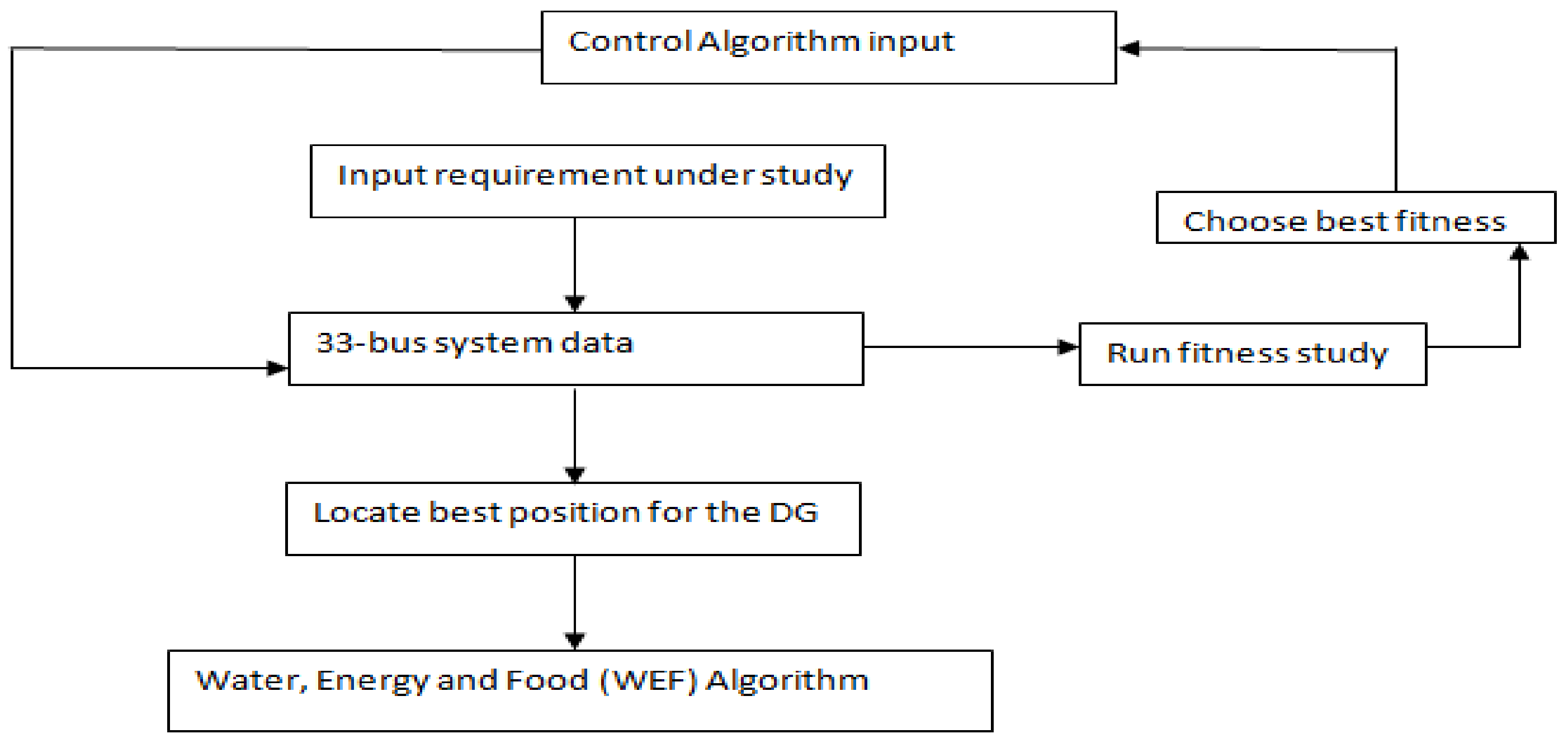
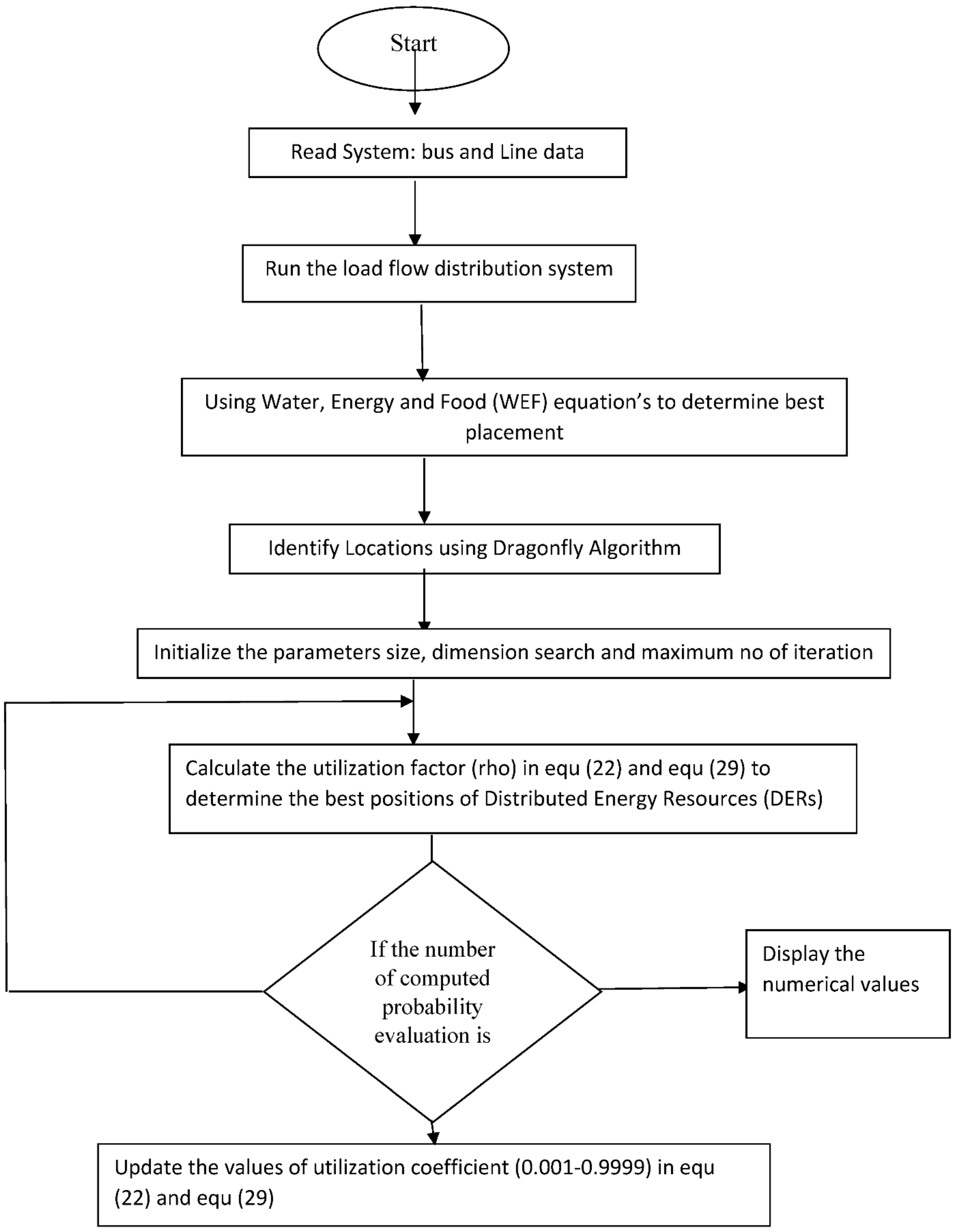
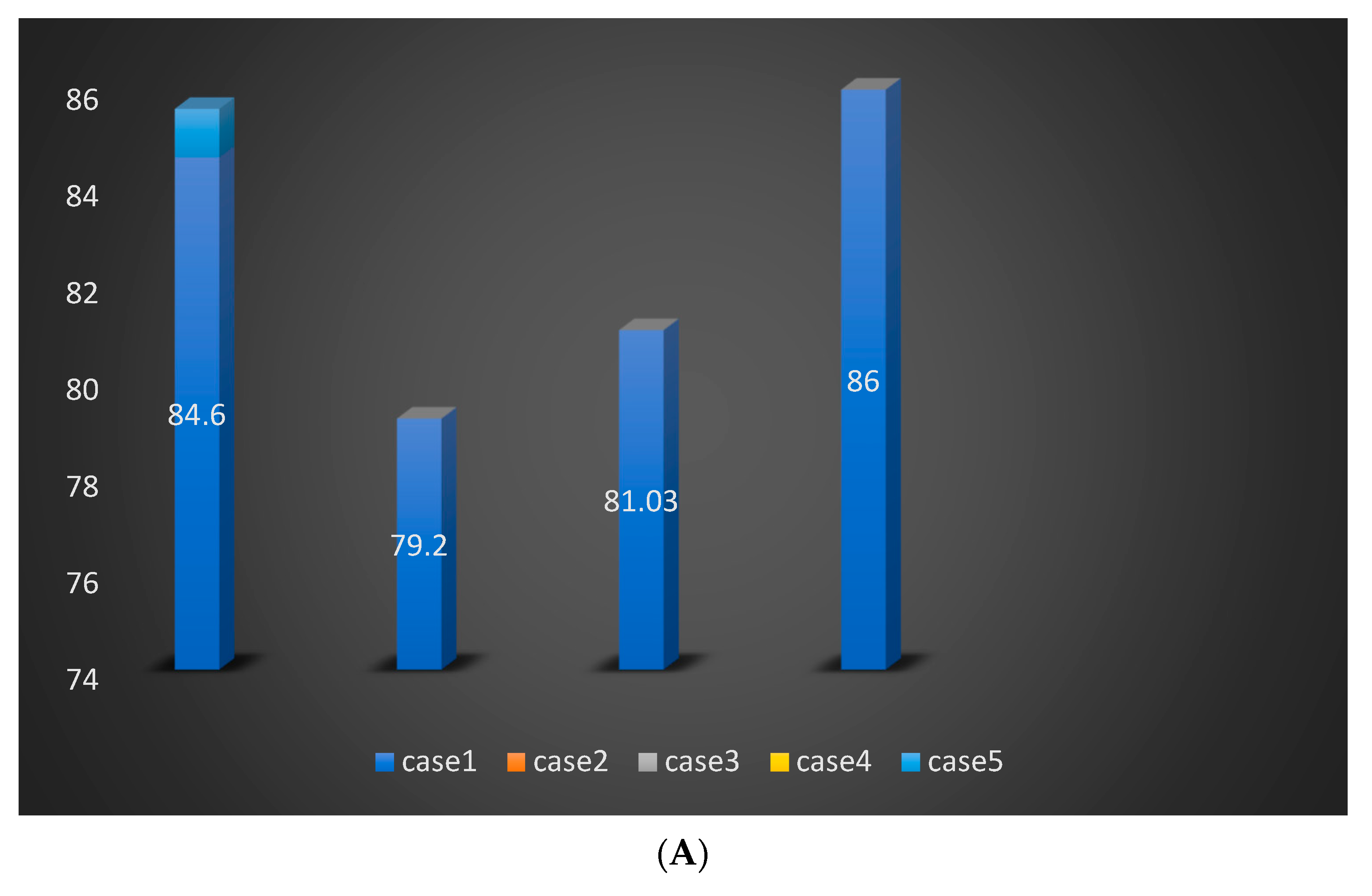
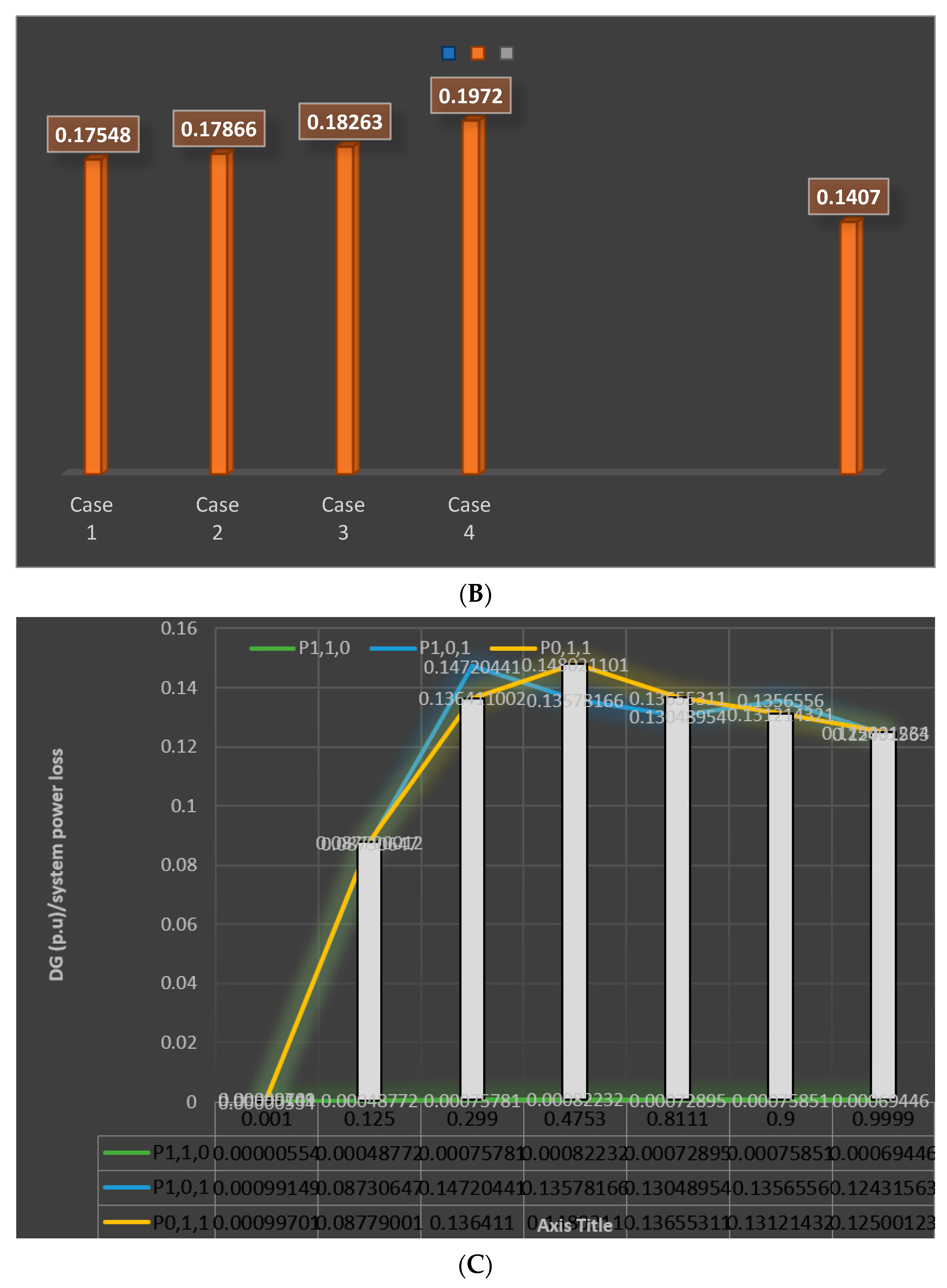
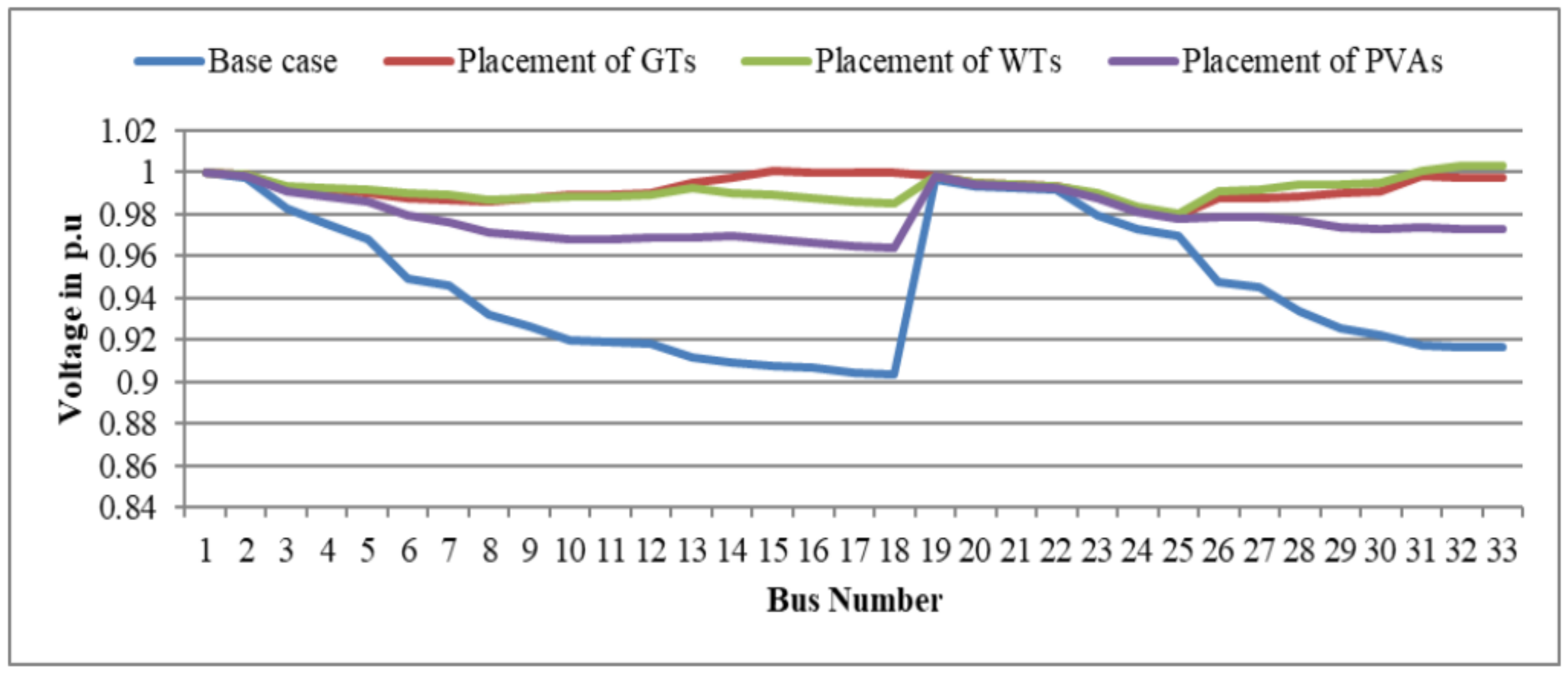

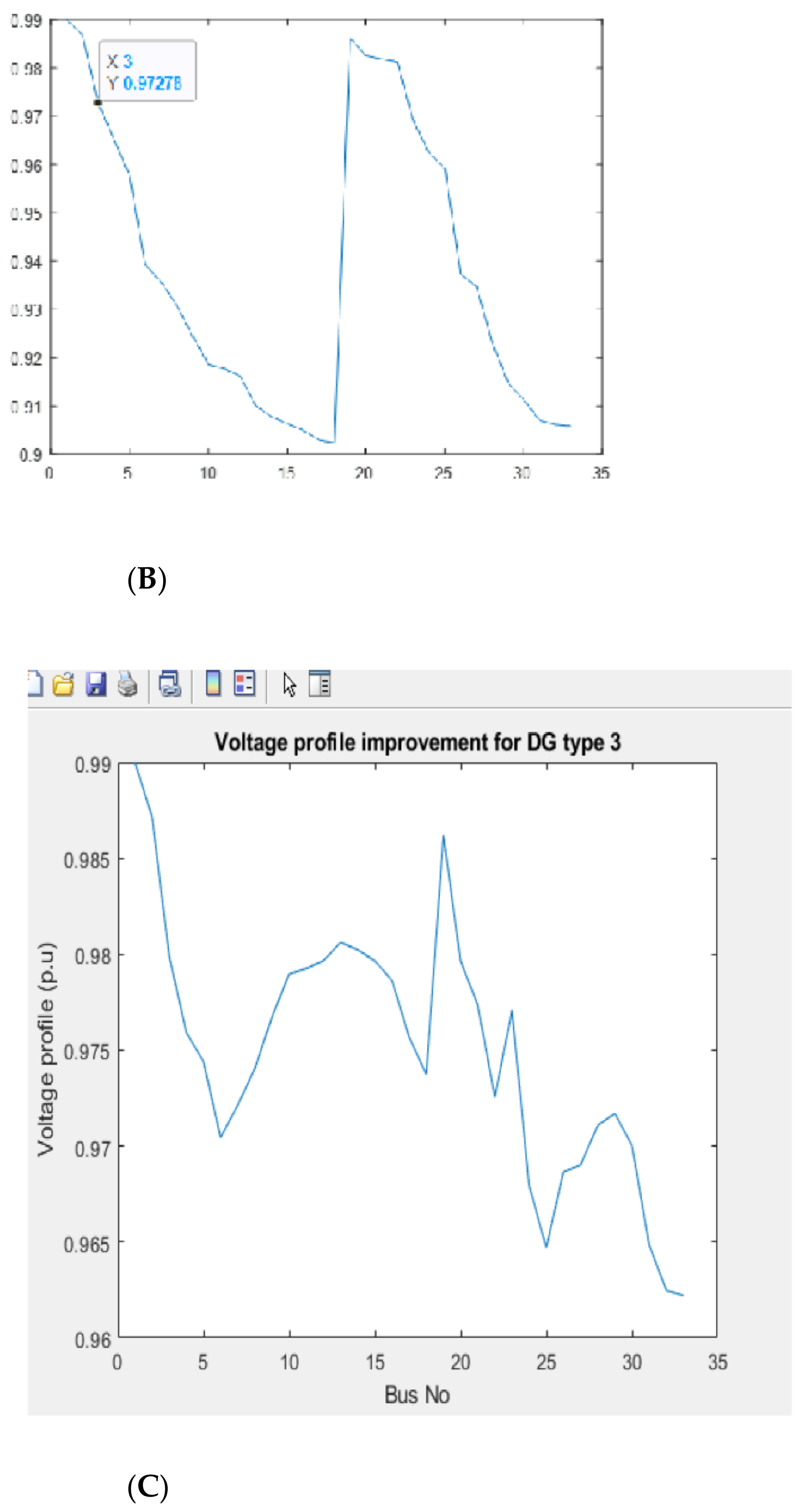
| 0.0010 | 0.730322055 |
| 0.1250 | 0.706831639 |
| 0.2990 | 0.358818766 |
| 0.4753 | 0.191723776 |
| 0.8111 | 0.182632786 |
| 0.9000 | 0.178659698 |
| 0.9999 | 0.175479984 |
| 0.0010 | 0.730322055 |
| 0.1250 | 0.619125122 |
| 0.2990 | 0.469749681 |
| 0.4753 | 0.566307961 |
| 0.8111 | 0.775099677 |
| 0.9000 | 0.649395187 |
| 0.9999 | 0.799201072 |
| P 1, 0, 0 | P 0, 10 | P 0, 0, 1 | |
|---|---|---|---|
| 0.0010 | 0.000071229 | 0.000005508 | 0.000991467 |
| 0.1250 | 0.000704904 | 0.000485012 | 0.087301243 |
| 0.2990 | 0.012646712 | 0.000753622 | 0.135657349 |
| 0.4753 | 0.015585902 | 0.0000817815 | 0.147200031 |
| 0.8111 | 0.017648764 | 0.000754350 | 0.135782257 |
| 0.9000 | 0.017793446 | 0.000724923 | 0.130490012 |
| 0.9999 | 0.017842872 | 0.000690621 | 0.124315576 |
| CASE1 | CASE2 | CASE3 | CASE4 | CASE5 | |
|---|---|---|---|---|---|
| DG CAPACITY IN (MW) | 0.5, 0.65, 0.7 | 0.6, 0.63, 0.8 | 0.4, 0.5, 0.75 | 0.50, 0.55, 0.7 | 0.6, 0.63, 0.65 |
| LOCATION OF BUS NUMBER | 31, 15, 9 | 31, 9, 15 | 25, 16, 11 | 25, 11, 16 | 31, 16, 11 |
| MAXMIUM POWER LOSS (KW) | 84.60 | 79.20 | 81.03 | 86.0 | 85.4 |
| VOLTAGE PROFILE IMPROVEMENT | 0.17548 | 0.17866 | 0.18263 | 0.1972 | 0.1407 |
| STABILITY INDEX | 1.146 | 1.1345 | 1.156 | 1.1713 | 1.173 |
| UTILIZATION RATE | 3.9 × 10−6 | 0.0354 | 0.1256 | 0.4542 | 0.5635 |
| EMISSION (IB/h) | 2046.18 | 1160.23 | 2303.67 | 4606.44 | 320.65 |
| Method | DG Location Bus Number/Bus Location | Voltage (p.u) | Power Loss (kW) |
|---|---|---|---|
| Genetic algorithm (GA) [45] | GA PSO 6 13 24 30 0.6429 0.8571 0.8571 0.7382 | 0.9703 | 0.0682 |
| BFOA [46] | 0.542 (17), 0.160 (18), 0.895 (33) | 0.978 | 41.41 |
| GA [47] | 0.25 (16), 0.25 (22), 0.50 (30) | 0.971 | 71.25 |
| WEF Case 1, 2 and 3 | 31 15 9 0.50 0.65 0.70 | 0.9622 * | 21.57 * |
| Active Power Loss | |
|---|---|
| Base model without a Gas turbine, Wind DG and Solar PV | KVAr |
| The base model with the Gas turbine, wind DG and Solar PV |
Publisher’s Note: MDPI stays neutral with regard to jurisdictional claims in published maps and institutional affiliations. |
© 2022 by the authors. Licensee MDPI, Basel, Switzerland. This article is an open access article distributed under the terms and conditions of the Creative Commons Attribution (CC BY) license (https://creativecommons.org/licenses/by/4.0/).
Share and Cite
Hassan, A.S.; Sun, Y.; Wang, Z. Water, Energy and Food Algorithm with Optimal Allocation and Sizing of Renewable Distributed Generation for Power Loss Minimization in Distribution Systems (WEF). Energies 2022, 15, 2242. https://doi.org/10.3390/en15062242
Hassan AS, Sun Y, Wang Z. Water, Energy and Food Algorithm with Optimal Allocation and Sizing of Renewable Distributed Generation for Power Loss Minimization in Distribution Systems (WEF). Energies. 2022; 15(6):2242. https://doi.org/10.3390/en15062242
Chicago/Turabian StyleHassan, Abdurrahman Shuaibu, Yanxia Sun, and Zenghui Wang. 2022. "Water, Energy and Food Algorithm with Optimal Allocation and Sizing of Renewable Distributed Generation for Power Loss Minimization in Distribution Systems (WEF)" Energies 15, no. 6: 2242. https://doi.org/10.3390/en15062242
APA StyleHassan, A. S., Sun, Y., & Wang, Z. (2022). Water, Energy and Food Algorithm with Optimal Allocation and Sizing of Renewable Distributed Generation for Power Loss Minimization in Distribution Systems (WEF). Energies, 15(6), 2242. https://doi.org/10.3390/en15062242






